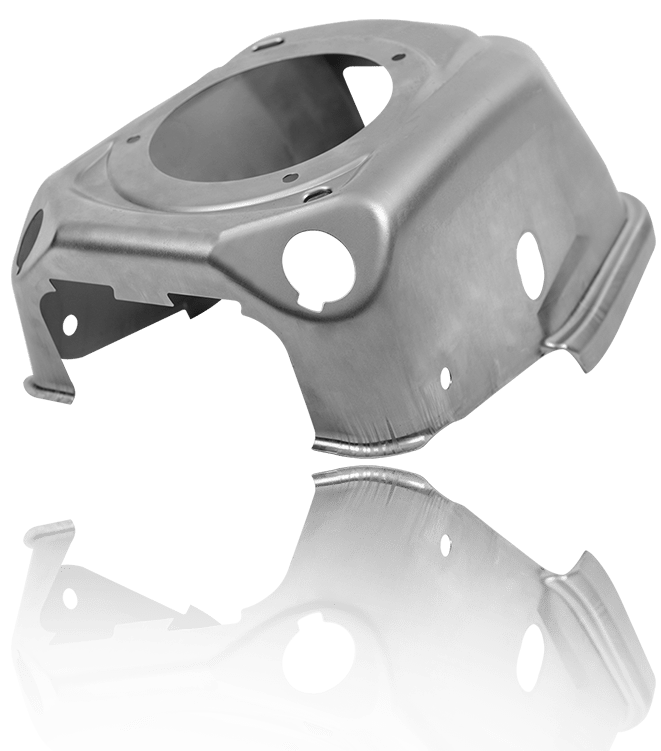Metal Marking Technologies: Elevating Manufacturing Processes for Superior Outcomes
In the world of producing procedures, steel marking has actually long been a cornerstone strategy for generating an array of precision components. With the relentless march of technical innovation, the landscape of steel marking is undertaking a substantial improvement.
Development of Metal Stamping Techniques

Furthermore, developments in material scientific research have resulted in the advancement of high-strength alloys that can currently be seamlessly stamped into complex forms, providing to a broader range of industrial applications. The combination of robotics and expert system has actually further optimized the marking procedure by boosting rate and accuracy while reducing the threat of human error.

Influence of Advanced Products
Have innovative materials changed metal marking procedures dramatically in the manufacturing sector? By utilizing products such as high-strength alloys, progressed composites, and cutting-edge finishes, metal stamping procedures can now generate elements that are lighter, stronger, and more long lasting than ever before.
These advanced materials use premium mechanical residential properties, deterioration resistance, and thermal stability, enabling producers to satisfy the needs of modern-day sectors such as aerospace, auto, and electronics. Additionally, the use of sophisticated materials in metal marking has actually promoted the manufacturing of intricate geometries and detailed layouts that were previously unattainable through standard techniques.
Moreover, the execution of innovative products has brought about minimized material waste, lower production expenses, and shorter lead times, making metal marking procedures a lot more cost-effective and lasting. As innovation remains to advancement, the impact of advanced materials on metal stamping procedures is anticipated to drive more innovation and enhance the competitiveness of manufacturers in the worldwide market.
Automation in Metal Stamping
The development of steel stamping processes driven by the integration of advanced materials has established the stage for significant improvements in automation within the production market. Automation in steel stamping has reinvented production processes, improving efficiency, accuracy, and general result quality. Through the utilization of robotics, sensing units, and computer-controlled systems, jobs that were taxing and when hand-operated can currently be performed with unparalleled rate and accuracy.
Automation in metal marking not just increases manufacturing prices but likewise makes certain uniformity in the manufacturing process. By reducing human treatment, the risk of mistakes is dramatically lowered, bring about greater levels of item harmony and reliability. Additionally, automation makes it possible for manufacturers to take on intricate marking tasks that would be impractical or tough to attain by hand.
Moreover, automation in steel stamping adds to a more secure working atmosphere by minimizing the requirement for staff members to engage in harmful or navigate to this website repeated jobs - Metal Stamping. This change in the direction of automation not just boosts productivity but also paves the method for the future of production, where technology plays a main function in driving operational excellence
Quality Assurance and Examination Equipments
With a concentrate on accuracy and integrity, high quality control and assessment systems play a vital role in making certain item excellence in steel marking processes. These systems are developed to monitor every stage of manufacturing, from product examination to the end product, to assure that all elements meet the required standards. By executing innovative modern technologies such as optical inspection systems, coordinate gauging makers (CMM), and automated gauging equipment, producers can find also the smallest inconsistencies in measurements, surface top quality, and total integrity of stamped parts.

Sustainability Practices in Metal Stamping
Structure upon the structure of accuracy and reliability developed via quality control and inspection systems, the combination of sustainable techniques in steel marking procedures is increasingly ending up being a centerpiece for makers seeking to reduce environmental influence and maximize resource utilization. Sustainability techniques in steel stamping incorporate an array of efforts focused on reducing waste generation, power intake, and greenhouse gas discharges throughout the manufacturing procedure.
One secret aspect of sustainability in steel stamping is the adoption of environmentally friendly products he has a good point and modern technologies that advertise recyclability and waste reduction. By making use of recycled products and carrying out energy-efficient equipment, producers can decrease their carbon impact and add to a much more sustainable manufacturing cycle. Furthermore, optimizing manufacturing processes to minimize product waste and power usage not only profits the atmosphere yet likewise results in set you back financial savings for services in the long run.
In addition, the application of sustainable techniques in steel stamping can boost brand reputation and attract ecologically conscious customers. As sustainability remains to gain value in the manufacturing sector, incorporating environmentally friendly campaigns into metal marking processes is vital for long-term success and competitiveness out there.
Final Thought
In final thought, metal stamping strategies have significantly developed gradually, incorporating advanced materials and automation to boost making processes. Quality control and assessment systems play a crucial role in guaranteeing premium outcomes, while sustainability techniques are progressively being carried out to lower environmental impact. These developments in steel stamping have transformed the market, bring about extra effective and sustainable production techniques for different markets.
Steel marking, as soon as a guidebook and labor-intensive process, has transformed into a very automated and innovative method of shaping metal sheets right into numerous forms and designs.Have sophisticated materials transformed metal stamping processes significantly in the manufacturing sector? By making use of products such as high-strength alloys, advanced composites, and ingenious coatings, steel marking processes can now produce parts that are lighter, more powerful, and a lot more resilient than ever before.
The evolution of steel stamping processes driven by the assimilation of sophisticated materials has actually established the stage for significant advancements in automation within the production market.In conclusion, steel stamping techniques have actually considerably evolved over time, including sophisticated materials and automation to improve making processes.